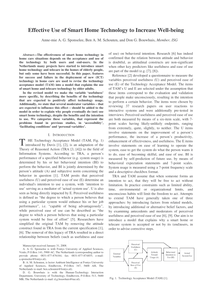Technology that supports older adults can have a positive effect on their psychological and physical well-being in a way that they may live independently for longer periods of time. This study is conducted to identify relevant factors that influence the use of smart home and telecare technologies in order to develop a measurement tool for telecare acceptance. In this study we revise the original Technology Acceptance Model (TAM) to explain the use of smart home and telecare technology by older adults. The model will be tested in the field by researching the use of telecare technology (with multiple functionalities, such as personal alarms, screen-to-screen communication, and teleservices) by approx. 100 Dutch households. The research will provide guidelines for design, implementation and functionality of smart home and telecare technology for older adults. It will provide insight into what features contribute to effective use of technology for older adults who live at home independently.
DOCUMENT

The effectiveness of smart home technology in home care situations depends on the acceptance and use of the technology by both users and end-users. In the Netherlands many projects have started to introduce smart home technology and telecare in the homes of elderly people, but only some have been successful. In this paper, features for success and failure in the deployment of new (ICT) technology in home care are used to revise the technology acceptance model (TAM) into a model that explains the use of smart home and telecare technology by older adults. In the revised model we make the variable 'usefulness' more specific, by describing the benefits of the technology that are expected to positively affect technology usage. Additionally, we state that several moderator variables - that are expected to influence this effect - should be added to the model in order to explain why people eventually do (not) use smart home technology, despite the benefits and the intention to use. We categorize these variables, that represent the problems found in previous studies, in 'accessibility', 'facilitating conditions' and 'personal variables'.
DOCUMENT

Expectations are high with regards to smart home technology. In particular, smart home technology is expected to support or enable independent living by older adults. This raises the question: can smart home technology contribute to independent living, according to older adults themselves? This chapter aims to answer this question by reviewing and discussing older adults’ perspectives on independence and their views on smart home technology. Firstly, older adults’ opinions on independence and aging in place are discussed. Secondly, this chapter will review to what extent smart home technology can support older adults’ independence. Thirdly, it will be explained how community-dwelling older adults’ concept of independence entails three distinct types or modes, and how these modes are related to their perceptions and acceptance of technology. In the last section of this chapter, an overview of key points is presented, and recommendations for technology designers, policy makers, and care providers are postulated.
LINK